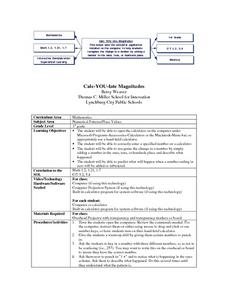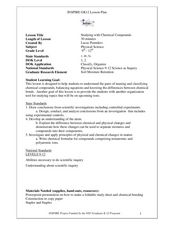Curated OER
Clickable Image Maps
Students understand the difference between server-side and client-side processes. They create an inline image that has different portions hyperlinked to other web pages, pictures, and other sites on the Internet.
Curated OER
Prospero: Turkey or Tyrant?
Students study characterization and the difference between subjective and objective points of view by creating tableaux to depict three interpretations of the story of Prospero's overthrow, each with a very different point of view. They...
Curated OER
Patterns, Relations And Functions
Fourth graders observe patterns and determine a mathematical function that creates the pattern. Through a demonstration by the teacher, they observe strategies such as multiplication, division, addition, and subtraction to use when...
Curated OER
Reading And Responding: Lesson 15 Nonfiction
Eighth graders examine a nonfiction selection in a teacher led lesson. They examine the author's purpose for writing the selection and identify the difference between fact and opinion. The compare and contrast expository and narrative...
Curated OER
Calc-You-Late Magnitudes
First graders are introduced and practice using a calculator. Individually, they enter and complete simple addition and subtraction problems. After the answer is displayed, they identify the place value for ones, tens, and hundreds...
Curated OER
Heat from Machines
Third graders continue their examination of the heat energy from machines. In groups, they make predictions on which machines might produce a measureable amount of heat. They take the temperatures of the various machines and record them...
Curated OER
To Classify Beans And Peas
First graders record information on a bar graph and interpret the information given. They identify five different kinds of beans and three different kinds of peas. They work in groups of four and sort the beans by size or shape.
Curated OER
Causal Patterns in Density Phenomena
Students realize that density exists. They develop a mental model of density-to realize that something is going on that they cannot see to account for differences between materials.
Curated OER
Comparative And Superlative Adjectives
Third graders watch "School House Rocks" video about adjectives. They discuss how adjectives both describe and compare things. They determine the difference between comparative and superlative adjectives and how to add "er" or "est" to...
Curated OER
The Journey of a Red Blood Cell
Fifth graders examine how a red blood cell travels throughout the body. Using a model, they follow the flow of blood throughout the entire body. They identify the functions of the lungs and discuss the difference of the blood entering...
Curated OER
Learning Birthdays With Chinese Calendar
Students participate in a visual arts lesson that focuses on patterns used in a macaroni necklace that represents the students' birthdays in the Chinese calendar. They compare the Chinese calendar to the one used in America and look at...
Curated OER
Interpreting Data-Working with Controls and Variables
Students review the meaning of control and variables, and state difference between dependent and independent variables. They complete a worksheet with the definitions and complete problems that show their understanding.
Curated OER
Measure-mania
Students research the history of measurement in this lesson. They compare todays units of measurement to historical units of measurement. For example, they weigh themselves on a bathroom scale and figure out how many of them it would...
Curated OER
Shells
Students participate in an activity that reinforces their skills with subtracting of two-digit numbers. They read in their Math Storybook's about seashells on the beach, hermit crab's and discuss how many they see and where did all the...
Curated OER
Concrete Lesson Plan
Students describe the difference between cement and concrete. In this technology lesson, students explain the mixing process of concrete. They discuss its importance in the modern world.
Curated OER
Weather Elements and Instruments
Eighth graders identify the different weather elements. In this earth science lesson, 8th graders explain the difference between relative humidity and dew point. They discuss the different instruments used to predict weather.
Curated OER
Studying with Chemical Compounds
Students create a foldable to help them remember topics on chemical compounds. In this physical science lesson plan, students differentiate ionic and covalent compounds. Given certain compounds, they identify whether it's ionic or covalent.
Curated OER
Get the Dirt
Students investigate a variety of soil samples placed in cold water jars. Layers of soil are examined for the difference between organic matter and rock fragments.
Curated OER
Strength in Summarizing
Third graders practice summarizing passages while creating a fishbone map of important details in non-fiction text. They examine how to tell the difference between important and less important details by highlighting them in reading...
Curated OER
Prononciation
Students practice pronouncing the u and y sound in French. While reading text, they make note of their mouth placement and identify the sounds used based on the spelling of the word. They complete a tongue twister and a homework...
Curated OER
Spot the Differences
In this spot the difference worksheet, students analyze pictures of two different wallabies to see if they can find six differences between the two.
Curated OER
Do the Tallywalker
Students study the basics of mapmaking, then make a tally walker, (geographic location device used in secret).
Curated OER
Decimal Baseball
Young mathematicians represent recorded information in decimal form. In this decimals lesson, learners play a "classroom friendly" basketball game in which pupils take 10 shots. Number of shots made out of 10 is recorded as a fraction...
Curated OER
Make Your Own Temperature Scale
Differentiate between temperature and thermal energy. Your class will build a thermometer using simple materials and develop their own scale for measuring temperature. Discuss with your class and consider why engineers need to understand...

























